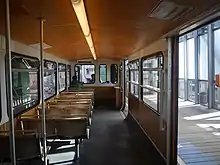GTW 72
The GTW 72 (GTW = "Gelenktriebwagen" or articulated railcar) is a suspended monorail train type operated by Wuppertaler Stadtwerke on the Wuppertal Schwebebahn from 1972 until 2018.
| GTW 72 | |
|---|---|
.JPG.webp) Set 22 at Oberbarmen Schwebebahn station in April 2016 | |
| In service | 1972–2018 |
| Manufacturer | MAN |
| Designer | Klaus Flesche |
| Constructed | 1972–1975 |
| Number built | 28 sets |
| Number in service | None |
| Successor | GTW 15 |
| Formation | 3 sections per trainset |
| Fleet numbers | 1–28 |
| Capacity | 48 seated, 156 standing |
| Operator(s) | Wuppertaler Stadtwerke (WSW) |
| Specifications | |
| Car body construction | Aluminium |
| Train length | 24,060 mm (78 ft 11 in) |
| Width | 2,200 mm (7 ft 3 in) |
| Doors | 4 pairs on the right side (in direction of travel) |
| Maximum speed | 60 km/h (35 mph) |
| Weight | 35,5 t |
| Traction system | Chopper-controlled DC motors |
| Power output | 4 x 50 kW |
| Electric system(s) | 600 V DC |
| Track gauge | Single track (monorail) |
Technical specifications
Each set consists of three sections.[1] The trains have welded aluminium car bodies, and are powered by four chopper-controlled motors, which power the two wheels of each bogie.[2]

Interior
Seating accommodation consists of transverse seating.[2]
History
The GTW 72 was designed by German architect Klaus Flesche.[3] A total of 28 sets were built by MAN between 1972 and 1975.[4] One unit derailed in the 1999 Wuppertal Suspension Railway accident.
Regular operations ended in November 2018 with the suspension of Schwebebahn services following problems with the power supply. The last set was removed from the tracks on July 11, 2019.[4] After their withdrawal from service, 21 units were sold, and three were donated under the condition that they stay within Wuppertal. Set 15 remains with Wuppertaler Stadtwerke. Set 6 was scrapped in early 2019.[4]
Preserved examples
References
- Schleife, Hans-Werner; et al. (1992). Metros der Welt [Metros of the world] (in German) (2nd ed.). Berlin: transpress Verlagsgesellschaft. pp. 377–379. ISBN 3-344-70715-9.
- Pabst, Martin (2006). S-Bahn- und U-Bahn-Fahrzeuge in Deutschland [S-Bahn and U-Bahn vehicles in Germany] (in German) (2nd ed.). GeraMond. pp. 88, 89. ISBN 3-7654-7366-9.
- "Alte Schwebebahn dreht in Wuppertal eine Abschiedsrunde" [Old Schwebebahn on a farewell run in Wuppertal]. nrz.de (in German). Funke Mediengruppe. May 23, 2019. Archived from the original on November 13, 2019. Retrieved November 13, 2019.
- "Nach 256 Tagen Stillstand: Wuppertaler Schwebebahn fährt wieder" [After 256 days of standstill: Wuppertal Schwebebahn resumes service]. Urban Transport Magazine (in German). August 4, 2019. Archived from the original on November 15, 2019. Retrieved November 19, 2019.
- Schlickowey, Sven (December 15, 2016). "Ein letztes Mal schweben" [Suspended for the last time]. bergischerbote.de (in German). Verlag am See GmbH. Archived from the original on November 20, 2019. Retrieved November 20, 2019.
- Besche, Thomas (November 13, 2019). "Wuppertaler Ebay-Schwebebahn erfolgreich verkauft" [Wuppetal Ebay-Schwebebahn successfully sold]. t-online.de (in German). Ströer Content Group. Archived from the original on November 15, 2019. Retrieved November 19, 2019.
External links
- Wuppertaler Stadtwerke official website (in German)